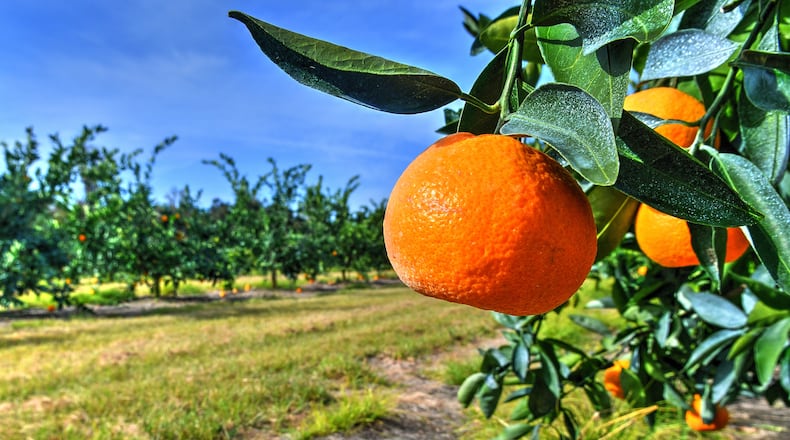LAKE PARK, Georgia – Swaths of acreage across rural south Georgia look very different compared to a few years ago.
Grove after grove of satsuma trees have now matured to become pixilated snapshots of orange and green during harvest season, the colors even more dramatic against the backdrop of cloudless blue skies on balmy November and December days. Sun-kissed orbs dangle in clusters from every branch, the weight of so much ripe fruit forcing the limbs to bow.
Satsumas have taken root as a commercially viable crop in Georgia, which has surpassed Florida and California to become the leading satsuma-producing state in the nation.
Nowhere has the growth of this industry become more visible than at Corbett Brothers Farms. Already among the largest vegetable-growing and packing operations on the East Coast, Corbett Brothers is one of the major players among Georgia’s satsuma growers, and its Besties brand of satsuma mandarins can be found at retailers throughout the Southeast in winter.
The Corbett family has been growing produce commercially since the early 1970s. Husband and wife Ken and Kim Corbett branched out with their own farm in 1987. It began with one acre of bell peppers, then expanded to squash, cucumbers, eggplant and cabbage, and now satsumas. That one acre has expanded into more than 3,000 acres across five counties in Georgia and Florida.
Ken Corbett was a visionary when he planted his first satsuma trees in 2013. Five years later, he was producing salable fruit. When he retired in 2019, sons Justin and Jared Corbett took over the business.
The brothers, 34 and 29 respectively, have been involved in their family’s farming operations their entire lives. Their hands-on learning aside, Justin Corbett cited two key factors for success: market conditions and the weather.
With some experts predicting a satsuma glut, and climate change visible everywhere, the next few years are about to get interesting.
Credit: Chris Hunt
Credit: Chris Hunt
‘The new Florida’
Juicy and floral, satsumas are regarded as the sweetest of all mandarins. Add to that an easily peeled rind and seedless character, and they are prime as a nutritious snack for kids and adults alike.
Satsumas thrive in warm, humid summers, and the trees can withstand temperatures as low as 15 degrees, all characteristics of the region labelled zone 8b — where most U.S. citrus is grown — on the USDA’s Plant Hardiness Zone Map.
Corbett Brothers Farms citrus groves sit in the center of zone 8b, which Justin Corbett estimates to be a swath that extends 60 miles north and south of their headquarters in Lake Park.
Jake Price, University of Georgia extension agent and coordinator for Lowndes County, said that Georgia citrus has proven to be surprisingly cold hardy, with satsumas topping the charts. “I’ve been working with citrus since 2013. My initial expectations: I was thinking we would probably lose a good bit of it and see which rootstocks worked the best.”
Instead, Price has seen citrus plants of every kind in Georgia prove tough against cold temperatures, especially compared to those in the Sunshine State.
“The temperatures we get here would kill the trees in Florida,” Price said. “Here we have a gradual winter, and the trees adjust to it and kind of shut down. In Florida, they don’t have a period to adjust.”
What’s more, Georgia hasn’t experienced tree-killing temperatures for quite some time.
“We haven’t been below 20 degrees since 2013 that I’ve recorded,” said Price. “If all the climate heats up, we could be the new Florida as far as citrus.”
Learning the ins and outs of satsuma growing has been a lot of trial and error for the Corbetts, despite their research and support from UGA Extension and the fledgling Georgia Citrus Association.
They’ve watched freezing temperatures threaten March blossoms and learned to fight back with microjets that send a mist of 72-degree water to delicate flowers. That technology did not exist in the 1980s when earlier attempts at citrus growing in Georgia were devastated by winter freezes.
The thin skins of mandarins are also vulnerable to bruising and wind scarring, which tends to occur when the fruit is young.
Mites and other scaly insects threaten cosmetic damage to the fruit, which also get sprayed with sunscreen to protect the peel.
Thus far, they have not detected citrus greening, a disease spread by a tropical brown-winged insect called the Asian citrus psyllid. This disease, which usually kills the trees, was once localized to groves in Florida but has moved into Georgia. It is being actively tracked, with insect trapping efforts underway in 32 Georgia counties.
Credit: Chris Hunt
Credit: Chris Hunt
Leader of the pack
Soon after Ken Corbett planted his first satsumas in 2013, the UGA Extension hosted a meeting of would-be citrus growers in the state. The gathering targeted people with small acreage with the goal of encouraging them to plant between 1 and 5 acres to sell to local school districts. “A nutritionist for Lowndes County came and told what it would take to get it into the schools. She said they wanted them,” recalled Price. “We had people from the University of Florida who talked economics. Everyone got excited.”
Less than a decade later, satsumas comprise an estimated 85% of the total acreage (2,300 out of 2,700 acres) dedicated to citrus production in Georgia. Those citrus trees do not all currently bear harvestable fruit, but they will soon. Compared to the 8.4 million pounds of citrus harvested in 2021, 59 million are projected by 2024.
But Corbett Brothers has a leg up on the competition. Its top-tier satsumas are sold under the Besties label, having joined branded mandarins like Halos, Cuties and Delite in the marketplace in 2019.
Various factors determine which fruit makes the Besties cut. Skin color is the first indicator, but science dictates when to pick. Ultimately, that comes down to a refractometer, used to measure sugar content.
Knowing they wanted to bring their fruit to market as a brand, the Corbett family established their sugar benchmark in 2019 after having submitted samples to food scientists at UGA’s Food Product Innovation and Commercialization Center in Griffin, which assists food businesses looking to launch a product.
Once the sweet spot is detected, there’s a rush to harvest the fruit (by hand so that the delicate skin is not damaged) before it becomes too soft to withstand shipping. At the 175,000-square-foot packing facility in Lake Park, the crop is sanitized, dried by heated blowers, wax coated to extend shelf life and dried again. A sorter mechanically separates the fruit by size.
Those deemed Besties-worthy go through a final hand-sorting quality check for scarring, green skin or malformed shape before the fruit is weighed, packed into 2- and 3-pound mesh bags at the rapid rate of 2,500 bags per hour and moved to cold storage.
Satsumas that are classified as premium-grade but not up to Besties standards are sold in the retail market. However, blemished and otherwise imperfect fruit — marked as grade 2 — is a harder sell among retail consumers.
“We are where they demand near perfect with grocery stores,” said Corbett.
Grade 2 fruit typically hits wholesalers and frequently lands in the food service sector. “A lot of them actually wind up going to kids in schools across the Southeast,” he said.
“They all have their home,” he said of the harvested fruit.
Food that doesn’t sell is sometimes donated. In 2020, they gave away 10 semi-truck’s worth of produce.
Credit: Chris Hunt
Credit: Chris Hunt
Skin in the citrus game
Time will tell whether the Besties and the non-branded satsumas have a home in the coming years. Corbett Brothers Farms has planted 200 acres of satsumas, but they are only harvesting 30% of the fruit, as they wait for the rest of the trees to mature and produce a commercially viable product.
Corbett expects a four-fold increase in the next five years. Other satsuma growers in the state also anticipate an increased yield in a matter of years. That leaves Price, the UGA Extension officer, a bit worried.
“I am concerned that there are so many satsumas out there now that have not yet produced. They all come in at the same time. I am afraid … there will be a glut of satsumas,” he said.
Satsuma growers could probably withstand a glut because citrus is “still not their main game. It’s just a part of their farm. It’s not the main driver for anyone,” said Price. Still, he recognizes that farms as big as Corbett Brothers have more skin in the game than most Georgia citrus growers. “They are taking a bigger chance,” he said.
Corbett sees the possibility of a satsuma windfall in a more positive light. “It can actually be a good thing,” he said. “Satsumas are gaining more of a market presence. That is getting the attention from retailers and other outlets for the product. We need enough volume to supply the needs of the customer. It’s hard to get (retailers) to promote something that is in one week and out the next.”
Even if satsumas remain Georgia’s flagship citrus fruit, Price encourages growers to plant other citrus varieties. “If you want to have a citrus industry, you have to diversify what you grow,” he said. “There are a lot of other citrus that have worked pretty well.”
Among those he cited a mandarin hybrid called Sugar Belle that ripens in mid-December, after satsumas. Plus, it enjoys a wider harvest window than satsumas and can hang on the tree until February.
The Corbetts are a step ahead of the game. Just as when they started with only a few acres of satsumas before slowly scaling up, they have planted a few test plots of other citrus species — primarily grapefruit and a Japanese mandarin hybrid called shiranui — that will reach maturity in a year or two.
“With anything we do, diversity is not a bad thing,” Corbett said.
Find more stories about Georgia farmers and recipes for their products at ajc.com/georgia-on-my-plate.
Sign up for the AJC Food and Dining Newsletter
Read more stories like this by liking Atlanta Restaurant Scene on Facebook, following @ATLDiningNews on Twitter and @ajcdining on Instagram.
About the Author





